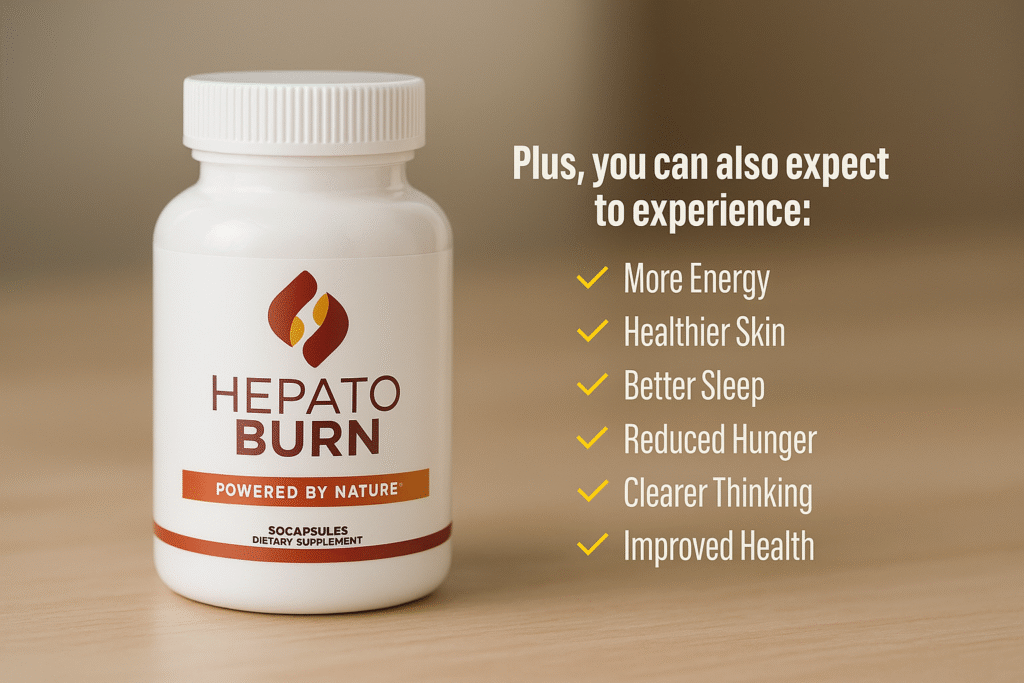
Starting your weight loss journey can feel overwhelming, especially when you’re balancing work, family, and a packed schedule. The mix of hope and doubt is real—but you’re not alone. This beginner-friendly weight loss guide is designed to meet you exactly where you are, offering simple, practical steps you can start using today to build a healthier, more energized life.
Healthy weight matters beyond the scale: it supports daily energy, lowers heart risk factors, and improves long-term quality of life when paired with good nutrition, activity, sleep, and stress management.
This how-to guide lays out realistic tips and a plan to keep momentum on your journey. Expect clear goals, behavior tracking, eating and activity strategies, sleep and stress tools, and ways to protect your money and health when evaluating products like HepatoBurn.
Small, consistent actions add up. You’ll learn stepwise changes that fit busy lives and how to measure progress so success is steady and safe.

Key Takeaways
- Focus on steady progress—about 1–2 pounds per week is sustainable and safer.
- Even a 5% reduction in body mass can improve blood pressure and glucose.
- Practical tips include goal-setting, behavior tracking, and skills for healthy eating.
- Evaluate supplements and claims critically; a review of HepatoBurn is included later.
- Small, consistent changes fit busy schedules and lead to long-term success.
Why a Healthy Weight Matters Right Now
Small, steady changes can deliver noticeable health gains much sooner than you might expect.
Reaching and keeping a healthy weight improves key markers right away. Losing even 5% of body mass—for example, about 10 pounds for someone who weighs 200 pounds—can lower blood pressure, improve cholesterol, and help control blood sugar.
Those changes cut risk for heart disease, prediabetes, and type 2 diabetes. They also boost everyday energy, sleep quality, and mood. Better stamina at work and more ease playing with family are common benefits.
- Small steps in nutrition, activity, sleep, and stress make progress sustainable.
- Many factors affect results—medicines, medical conditions, genes, hormones, environment, and age—so compassionate, personalized management is key.
- Acting today builds early wins that create momentum for lasting change.
“Safe, evidence-based approaches beat quick promises every time.”
Later sections translate these benefits into practical strategies and a careful review of products like HepatoBurn to help you choose what truly supports long-term health.

Get Started: Define Your Reasons and Goals for Weight Loss
Start by naming the real reasons you want change and keep them where you’ll see them every day.
Write down why you want to get started. Put that note on your phone lock screen, fridge, or desk to remind you each day.
Clarify your “why” and keep it visible daily
Make reasons specific. For example, “I want lower family heart risk” or “I want more energy to play with my kids.” Visible reminders help steady motivation and make it easier to question quick-fix claims like HepatoBurn later.
Set specific, realistic short-term goals
Convert reasons into clear goals and a simple plan. A strong short-term example: “I will walk 15 minutes, 3 days this week.” If that proves too hard, revise to two days. Small wins build confidence.
Aim for gradual progress: about 1-2 pounds per week
Pick one step per week and track it. This pace helps protect muscle, supports adherence, and fits busy schedules. Align goals with work and family time so you don’t derail daily life.
- Document reasons and place them in daily view.
- Turn reasons into measurable goals and a simple plan.
- Use one small step each week and review progress on a set day.
| Action | Short Goal (example) | When |
|---|---|---|
| Cardio | Walk 15 min, 3x this week | Evening, Mon/Wed/Fri |
| Nutrition | Add one vegetable at dinner | Daily |
| Review | Check goals and adjust weekly | Sunday evening |
Track What You Do: Nutrition, Physical Activity, Sleep, and Stress
Collecting basic daily notes on food, movement, sleep, and stress creates a clear map to improve habits.
Food and beverage diary: small swaps for healthy eating
Keep a simple food and beverage diary for a few days to reveal patterns. Record what you eat, approximate portions, and when you ate.
Small swaps like adding a vegetable at dinner or switching a sugary drink to water often show up as easy wins once you track them.
Activity log: time, duration, and type of exercise
Note the time of day, type, and duration of each activity so you can balance intensity across the week.
This helps spot missed opportunities and plan brief movement breaks during busy work periods.
Sleep routine: consistent schedules that support weight management
Track sleep hours and set steady bed and wake times. Avoid caffeine in the afternoon and turn off devices at least 30 minutes before bed.
Stress check-ins: identify triggers and coping strategies
Write quick stress notes and the coping step you took. Over time, patterns point to practical fixes.
- Address common challenges: take walk breaks at work, plan meals, and keep produce on hand.
- Use low-cost apps or a paper tracker and save key resources to revisit during plateaus.
- One step at a time: pick one metric to track first, then layer others as it feels manageable.
- Use a weekly review to connect tracked data to results and refine your approach.
Data first. Monitor behaviors before considering products so you can evaluate claims with real-world context and protect your wellness.
Build Sustainable Habits That Fit Your Life
Pick a couple of steady habits and let them anchor your days rather than chasing quick fixes.
Focus on two to three changes at a time
Keep your habit load light. Choose two or three realistic actions that match your schedule. Too many new actions at once makes routines hard to keep.
Write a weekly plan that links each action to a calendar reminder. This connects habits to your goals and makes follow-through easier.

Plan for setbacks and reset quickly
Setbacks are normal. Expect occasional missed days and return to your plan without guilt.
Use these quick reset steps: note what happened, tweak the step to reduce friction, and schedule the next attempt within 24–48 hours.
- Reduce friction: prep snacks, set gear by the door, and simplify choices.
- Pair new actions with existing routines (habit stacking) to make them stick.
- Celebrate process wins—count completed steps like “10 walks” to build identity.
| Review Item | What Worked | What to Change | Next Week Plan |
|---|---|---|---|
| Goal 1 | Walked 3 times | Move one walk to morning | Walk Mon/Wed/Fri 15 min |
| Goal 2 | Added veg to dinner | Prep veggies on Sunday | Prep 3 dinners, daily veg |
| Reset Step | Quick restart helped | Set phone reminder | Reminder daily at 6:30 PM |
“Consistency beats intensity; small steady steps build lasting success.”
Healthy Eating Made Practical: Foods, Recipes, and Planning
Simple, family-friendly food choices make healthy eating feel doable every day.
Balance your plate
Build a satisfying plate with lean protein, high-fiber carbs, healthy fats, and colorful produce. This combo keeps you full and supports good nutrition without strict rules.
Smart swaps that stick
Swap sugary drinks for water or sparkling water and replace refined snacks with fruit, nuts, or whole-grain crackers. Small swaps like these help you manage intake and keep meals simple.
Quick meal planning for busy nights
Spend 15 minutes planning: list three dinners, pick one batch-cook item, and add staples to your shopping list. Use frozen vegetables, canned beans, and rotisserie chicken to save time.
Family-friendly recipes and cultural variety
Choose recipes that honor family tastes and cultural favorites. The American Heart Association and similar sources offer many approachable options that fit diverse tables.
Non-food rewards and simple cues
Celebrate progress with non-food rewards—fresh flowers, a movie night, or a relaxing bath. Use plate cues: half the plate produce, a quarter protein, a quarter whole grains.
“Small, steady changes to what you eat and how you plan make healthy eating practical for busy homes.”
| Action | Quick Example | Why it Helps |
|---|---|---|
| Plate balance | Half veggies, quarter protein, quarter grain | Manages portion naturally and boosts nutrients |
| Smart swap | Water instead of soda; fruit for chips | Reduces added sugar and keeps energy steady |
| 15-min plan | Pick 3 meals, batch-cook one, buy staples | Reduces takeout and decision fatigue |
Move More: Physical Activity Strategies That Work
Find simple movement habits that fit your schedule and feel fun—that’s the best way to keep going.
Try a variety of activities. Experiment with walking, swimming, tennis, or a group exercise class. Finding one or two you enjoy raises the chance you’ll repeat them.
Mix short bursts into your day
Micro-movements add up. Take brief walk breaks at work, choose stairs, or stand during calls. These small steps increase total activity without needing extra time.
Progress gradually
Start by adding minutes, then add days, and finally boost intensity. This protects joints and reduces injury risk while helping you slowly lose weight in a steady way.
- Pair movement with routines: walk at school drop-off or pace during phone calls.
- Turn commutes into activity: bike, walk part of the trip, or park farther away.
- Track weekly activity and celebrate consistency to keep motivation high.
Quick home circuit (no equipment)
Do 3 rounds of: 10 squats, 10 push-ups (knees OK), 20-second plank, 30 seconds marching in place.
Scale by changing reps, rounds, or rest time to match your level.
Exercise complements nutrition and helps protect muscle as you progress. Focus on enjoyable activity and steady progression rather than shortcuts or products for long-term success.
Sleep, Stress, and Body Image: The Often-Overlooked Pillars
Good rest and steady stress care shape daily choices and long-term wellness. These pillars support recovery, appetite control, and hormone balance that affect overall health and diabetes risk.
Simple sleep hygiene that helps
Set regular sleep and wake times and keep them most days. Avoid caffeine after mid-afternoon to reduce night awakenings.
Turn off devices at least 30 minutes before bed and build a short wind-down routine. Lay out tomorrow’s clothes, prep a simple lunch, and dim lights to signal rest.
Stress management that keeps plans on track
Use brief walks, focused breathing, or a quick call with a friend to reset during tough moments. Track which steps help in your daily notes so you can repeat them.
Social support and short, repeatable practices improve adherence and reduce shame-based cycles. Self-compassion helps performance—treat setbacks as data, not proof of failure.
Reframe body image around function and health markers rather than perfection. Celebrate gains in energy, strength, sleep quality, and mood instead of focusing only on numbers.
“Small routines for rest and calm improve decisions on hard days.”
- Audit triggers: newsfeeds, mirrors, or clothing that spark negative feelings and replace them with supportive cues.
- Document sleep and stress steps in your tracker to see what boosts wellness and adherence.
Professional Support: Programs, Medications, and Bariatric Surgery
Licensed professionals and structured programs can give clear plans, safety checks, and the follow-up you need. They match treatments to your health, track labs, and coordinate care to lower diabetes and heart risks.

Choosing a safe program
Vet programs for qualified staff, realistic timelines, behavior support, and transparent costs. Ask about credentialed clinicians, program goals, and how progress is measured.
When prescription medications may help
Talk to your health care team if lifestyle steps alone aren’t enough. Clinicians can discuss federally approved medications, type and dose, interactions, and how meds fit into overall management.
Considering bariatric surgery
Bariatric surgery is for specific candidates and requires pre-op nutrition counseling and long-term follow-up care. Expect behavior change support, lab monitoring, and close coordination among specialists.
- Schedule follow-up visits to adjust treatments and check side effects.
- Bring questions about expected outcomes, interactions, and monitoring plans.
- Use clinician referrals and community resources to find registered dietitians and programs that match your budget.
| Option | Who Provides It | Key Follow-up |
|---|---|---|
| Behavioral program | Registered dietitians, counselors | Weekly check-ins, goal adjustments |
| Prescription medications | Primary care or specialists | Lab monitoring, dose review |
| Bariatric surgery | Surgeons, multidisciplinary team | Long-term nutrition and medical follow-up |
“Professional help complements daily habits and speeds safe, sustained progress.”
HepatoBurn Review: Claims, Evidence, and Safety Considerations
Before trying any new product, compare bold marketing claims with real clinical evidence.
What HepatoBurn claims vs. what evidence supports
HepatoBurn marketing often promises rapid weight loss and detox effects. Independent, peer-reviewed trials proving those exact outcomes with the product formula are limited or absent.
Healthy change tends to be gradual — about 1–2 pounds per week — through steady eating, activity, sleep, and stress habits. That pace is the benchmark when evaluating any supplement’s claims.

Red flags: unrealistic timelines and fine print
Watch for miracle language, tiny disclaimers that require strict diet or exercise, and testimonials instead of clinical data. These are common signs a product is overhyped.
Safety first: interactions and consulting providers
Supplements can interact with prescription medications and affect conditions such as diabetes. Check ingredients, third-party testing, and manufacturing transparency.
- Verify refund policies and auto-ship terms as an example checklist item.
- Look for published clinical studies that match dose and formulation.
- Ask your clinician or pharmacist about interactions with your medications and overall care plan.
“Treat supplements as optional tools, not essentials; prioritize proven behaviors and medical guidance.”
Community and Resources: Make Your Environment Work for You
Activate nearby services and social networks to turn intention into routine today.
Leverage local options
Map local resources such as farmers markets, food pantries, parks, and trails. Use them to plan affordable meals and outdoor activities each week.
Find market days, pantry hours, and trail maps online or at your library and add them to your calendar.
Build social support
Ask coworkers, neighbors, or friends to join short walks or swap simple recipes. Small groups make new behaviors easier and more fun.
- Turn a nearby park into a weekly meet-up for casual activity.
- Share strategies for buying affordable produce at markets and pantries.
- Form a team at work to trade healthy snacks and schedule walk breaks.
“Community makes healthy living practical and social.”
| Resource | Who Runs It | What to Track |
|---|---|---|
| Farmers market | Local vendors | Cost saved on produce |
| Park/trail | Parks & Rec | Steps per visit |
| Food pantry | Nonprofit | Meals supplemented |
Try this script to start a wellness committee at work: “Hi HR—can we form a brief wellness group to add walk breaks, healthier meeting options, and snack swaps?”
Make a short list of go-to resources and place walking shoes by the door to nudge new habits.
Conclusion
Summing up: clear reasons, steady actions, and simple tracking set the stage for lasting change.
Core takeaways: define your why, set specific goals, and use small, consistent steps to lose weight sustainably. Aim for about 1–2 pounds per week as a safe pace for long-term weight management.
Quick-start checklist for this week: log meals, add one vegetable daily, walk 15 minutes three days, set a nightly device cutoff, and plan two simple dinners. Use a strong, realistic goal and track progress.
Supplements like HepatoBurn are optional; prioritize behavior change and consult a clinician when needed. Celebrate non-scale wins—more energy, better sleep, steadier routines—and review progress monthly.
Engage community supports and keep going: small actions compound, and your next meal, movement, and bedtime are steps toward healthy living today.
FAQ
What are realistic short-term goals I can set to start losing pounds safely?
Aim for gradual progress of about 1–2 pounds per week. Break that into short-term targets like a two-week goal to swap sugary drinks for water, add three 20-minute walks per week, or plan three balanced dinners. These small steps build habits and are easier to sustain than drastic changes.
How do I clarify my “why” so I stay motivated every day?
Write a concise motivation statement—health, energy, diabetes prevention, or fitting into a favorite outfit. Place it where you’ll see it: fridge, phone lock screen, or workout gear. Pair that reminder with specific actions (meal plan, daily steps) to turn intent into behavior.
What should I track to see real progress aside from the scale?
Track food and beverage intake, physical activity (type, duration), sleep hours and quality, and stress levels. A simple diary or app helps identify patterns—like late-night snacking or missed workouts—so you can make targeted adjustments.
Which foods and swaps help me feel full while managing calories?
Focus on nutrient-dense foods: lean proteins, whole grains, vegetables, legumes, and healthy fats like avocado or olive oil. Swap sugary drinks for water or sparkling water, replace refined snacks with fruit or nuts, and choose whole-grain bread over white. These swaps boost satiety and nutrition.
How can I plan meals if I have a busy schedule or family to feed?
Use batch cooking and simple templates: a lean protein + vegetable + whole grain. Prep ingredients on one day, rehearse two or three family-friendly recipes, and use slow cookers or sheet-pan meals for minimal active time. Involve family with culturally familiar dishes to keep everyone satisfied.
What types of physical activity are most effective for long-term success?
A mix works best: brisk walking, swimming, cycling, and group classes for cardiovascular fitness; strength training twice weekly to preserve muscle; and flexibility or balance work. Start with activities you enjoy and build duration and intensity gradually.
How do micro-movements throughout the day help my efforts?
Small choices—taking stairs, short walk breaks, standing while on calls, or parking farther away—add up. These micro-movements boost daily calorie burn, improve mood, and make an active lifestyle easier to maintain alongside structured exercise.
What sleep and stress habits support healthy body changes?
Prioritize consistent sleep times, limit caffeine after mid-afternoon, and set a device cutoff 30–60 minutes before bed. For stress, identify triggers and use quick coping tools like deep breathing, short walks, or brief journaling to prevent emotional eating and preserve motivation.
When should I consider professional programs, medications, or surgery?
Seek professional help if you have diabetes, high blood pressure, or other chronic conditions, or if lifestyle changes don’t produce progress. A clinician can discuss safe programs, prescription options, or bariatric surgery candidacy and expected outcomes. Always review risks, benefits, and long-term follow-up.
How can I evaluate supplements or products like HepatoBurn for safety and effectiveness?
Look for credible evidence from clinical studies, check ingredient lists for interactions, and watch for red flags—promises of rapid results or “miracle” language. Discuss any supplement with your healthcare provider, especially if you take medications or have liver or metabolic conditions.
What local resources can help me stay on track without spending much money?
Use community options: farmers markets for affordable produce, parks and trails for free activity, food pantries offering healthy staples, and library programs for nutrition or exercise classes. Workplace wellness groups and neighborhood walking buddies add social support.
How should I handle setbacks so I don’t lose progress?
Expect setbacks and plan a quick reset: review your tracking notes, identify one small corrective action (shorter fast-food detour, extra walk), and refocus on your next 24–48 hours. Celebrate small wins and return to two or three prioritized habits rather than trying to overhaul everything at once.